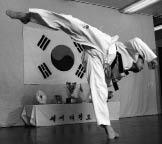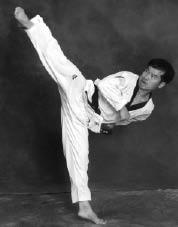Complete Kicking (4 page)
Authors: Turtle Press

EXERCISE: When you practice spinning kicks like those shown below, tense your lower abdomen to focus your center and relax your terminals (upper body and kicking leg). When you feel confident with a spinning kick, try practicing 2, 3, 4 or 5 in quick succession with the same leg to see how this affects your balance. If your kick is technically, you should have no problem.
After kicking, let go until the force becomes zero, then let your leg return to its natural original position.

Keep your torso balanced between both legs for high kicks.

the bones
key point:
Kicking requires coordination of complex movements of the legs, hips, spine, shoulders, arms and head. The bones of your skeleton facilitate these movements.
overview:
The skeletal structure of the body protects the organs and provides levers to facilitate movement. The placement of each bone is deliberate, exact, and in many cases, symmetrical. These characteristics are important to kicking because your kicking needs to be deliberate, precise and balanced. The symmetrical structure of the skeletal system enables us to balance our body by stabilizing it against gravity.
Additionally understanding the anti-gravitational nature of the spine, pelvic girdle and the lower limbs is critical since we must stand and kick in opposition gravity and often we must struggle enormously against an opponent. For standing kicks, for instance, you need to stabilize your standing leg and spine to free the kicking leg from the constraint of gravity (photo a). For jumping kicks, extend both legs when the spine reaches the highest point of the jump where gravity is weakest (photo b).
Another key point to understand about the skeleton is that it made up of bones of varying lengths and functions. For example, the femur, the most powerful bone in the human body, allows us to control the speed and power of a kick.
The tiny phalanges, or toe bones, play almost no role in creating powerful kicks but they are critical in maintaining your balance while standing on one leg. Without toes, you would no more be able to deliver a proper roundhouse kick than if you lacked a femur bone. Each bone is designed to play a particular role in movement.
The skeleton by itself, however, is useless. It can only function with the help of the muscles and nervous system.
major bones
skull
The skull is made up of 29 bones forming the brain case and face. For kicking, it is important to know the the jawbone is the only moving bone in the skull. Tuck your chin and close your mouth when kicking.
spine
The spine is attached to the pectoral girdle at the shoulder, the pelvic girdle at the hip, and the rib cage (12 ribs on each side) at the torso, giving shape and height to the body for support. The vertebrae of the spine are made up of alternating layers of bone and compressible cartilage, which reduces shock, bears the weight of the body and prevents the vertebrae from grinding against each other.
pectoral girdle
The pectoral girdle is the set of bones that connect the arms with the shoulders. It is composed of the clavicle and scapular.
arm
There are 30 bones in the arm, 27 of them in the hands and wrist. The arms are balance equalizers, initiators and accelerators in kicking.
pelvic girdle
The pelvic girdle is located at the bottom of the spine. It consists of the sacrum, coccyx, and a pair of hip bones (ilium, ischium, and pubis). The pelvic girdle is the source of power in kicking.
leg
There are 30 bones in the leg, 22 of them in the ankle and foot. The femur, the most powerful and largest bone in human body, can bear a tremendous amount of pressure and weight. It is engineered for maximum strength and power. As a whole, the leg bones function to resist gravity by bearing the weight of the body during motion and at rest.
Spinal Curve
The spine is the backbone of the body: not only carrying the weight but also facilitating movement through mechanical balancing and counterbalancing. The 4 alternating curves in the spine aid in this job.
the joints
A joint is a point where two or more bones are connected. Although each joint works differently according to how the bones are joined, they are all built for movement and function as mechanical fulcrums. Therefore they play invaluable roles in kicking: transmission of force, facilitation of coiling/uncoiling the body and control of speed.
transmission of force
The joints are responsible for chain reactions in kicking: force originates from one source (for example, the left shoulder for right roundhouse kick), activating the motion of the pelvic girdle, travels through the limb (right leg for right roundhouse kick) to the extremity (right foot). To visualize this, imagine cracking a whip. You initiate the force in your hand and the force travels through the whip to the opposite end, which strikes a target. The whip is a powerful weapon because it is an efficient transmitter of force. (See page 22-23 for a detailed explanation of this concept.)
coiling/uncoiling
For circular techniques like roundhouse kick, turn kick and spinning whip kick, when a joint pivots in preparation for kicking, a coiling of force occurs. In the execution of the kick, an uncoiling action delivers the force of the kick to the target. For example, in steps 4-7 on page 35, the hip and knee joints create the coiling action and your body has the greatest amount of potential energy at this point in the kick. In steps 8-9, the knee and hip joints have uncoiled to deliver the force of the kick to the target.
control of speed
When force passes through a joint, according to the pivoting angle and intensity, the joint magnifies the force which results in an acceleration of speed. However, if your joints are stiff, your speed will decrease as force passes through them. To understand why, think back to the example of the whip. When you crack the whip, your action has one point of initiation—your hand—and one point of final force transmission—the opposite end of the whip. Imagine if you tried to control the whip not only at the handle end, but at two or three points in the middle. The force would be chaotic and randomly dispersed. The same is true of your kick when your joints lack the fluidity to transmit the force smoothly from origin to target.
sequence of kicking
Action #1: The contraction of the abdomen muscles pulls the lumbar curve forward (1).
Action #2: Action #1 triggers the sacral curve to snap froward (2).
Action #3: Action #2 causes the sternum and neck (3) to counterbalance the forward motion of the hip. Actions #1-3 take place almost simultaneously, in a fraction of a second.
Action #4: The left shoulder begins to turn to the left.
Action #5: The right hip joint projects forward.
Action #6: As the right hip begins to rotate to the forward left, the elbows (6) move to the right to counterbalance.
Action #7: As the elbows swing to the right, the right knee moves to the left in a circular motion.
Action #8: As the right knee reaches the high point, both hands snap further to the right, accelerating the force of the leg.
Action #9: The right foot impacts the target at maximum speed and power.

WHAT IS BALANCE?
Balance is the ability to maintain your body position both in movement and at rest. There are two types of balance: static and dynamic. Static balance is a stationary object at equilibrium, like when you stand upright. Dynamic balance, a.k.a. balance in motion, is a body moving at constant linear and angular velocities.
WHERE DOES IT COME FROM?
1. Balance at rest and in motion both originate with good posture. Align your feet, hips, spine and head when kicking to maintain a stable upright posture.
2. Keep your eyes fixed on one spot, preferably your target. Vision provides your body with a ready means of finding your position relative to the ground through the presence or absence of visual cues.
3. Tactile cues, such as the network of sensors in the pads of your feet, relay important information to your brain, allowing it to adjust your weight distribution and foot position as necessary.
4. The vestibular apparatus in the inner ear controls the righting reflex which helps you remain upright in motion.
KEY POINT: If your lose your balance, restore it quickly by first positioning your head upright and fixing your line of sight on one object, then allow your body to follow.
the muscles
primary function
The primary function of the muscles is to create movement of the skeleton (bones) through contraction and relaxation. Strengthening your major kicking muscles will enhance the power and flexibility of your kicks and help prevent common injuries.
major kicking muscles
For fast, powerful, well-controlled kicks, you need to develop three major muscle groups in the body:
• abdominal muscles: rectus and transversus abdominis
muscles, oblique muscles
• frontal thigh muscles: quadriceps femoris
Other books
Thatcher by Clare Beckett
Geek Heresy by Toyama, Kentaro
Hermoso Final by Kami García, Margaret Stohl
Undone by Lila Dipasqua
Dangerous to Know by Barbara Taylor Bradford
Whisper of Memory (Whispering Woods Book 2) by Berry, Brinda
Xenopath by Eric Brown
Jacquot and the Waterman by Martin O'Brien
Necessary Roughness (HotShots Book 1) by Courtney Cole
Red Velvet Cupcake Murder by Joanne Fluke